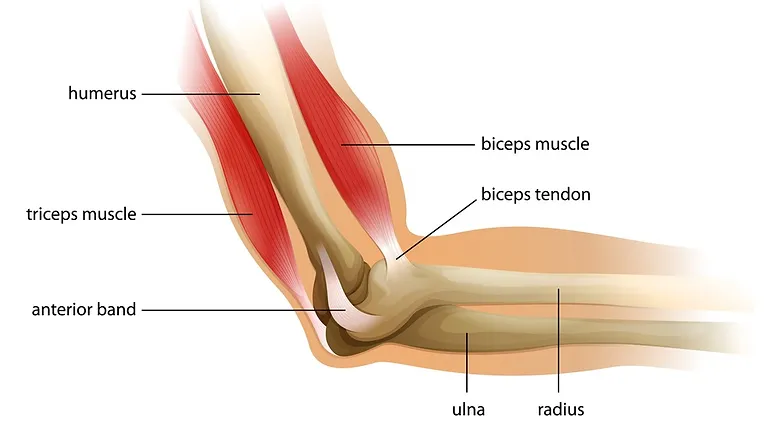Elbow Dislocation

A dislocated elbow occurs when the bones that make up the joint are forced out of alignment — typically when you land on an outstretched hand during a fall. The elbow is the second most commonly dislocated joint after the shoulder in adults, and the most commonly dislocated joint in children.
Toddlers may experience a dislocated elbow, sometimes known as nursemaid’s elbow, if they are lifted or swung by their forearms.
If you or your child has a dislocated elbow, seek immediate medical attention. Complications can occur if the dislocated elbow pinches or traps the blood vessels and the nerves that serve the lower arm and hand.
A dislocated elbow can usually be realigned without surgery. However, if your elbow is also fractured, you might need surgery.
ELBOW ANATOMY

DISEASE EXPLAINED

SYMPTOMS
Extreme pain
Obvious distortion of the joint
Toddlers with nursemaid’s elbow might experience pain only when the affected elbow is moved. A child often avoids using the arm and holds it slightly flexed next to the body.
Sometimes, the elbow is only partially dislocated. Partial dislocation can cause bruising and pain where the ligaments were stretched or torn.
CAUSES
In adults, the most common causes of a dislocated elbow include:
Falls. Falling onto an outstretched hand can pop the upper arm bone out of alignment within the elbow joint.
Motor vehicle accidents. The same type of impact can occur when passengers in motor vehicle accidents reach forward to brace themselves before a collision.
In children or teenagers, falling onto an outstretched hand is also a common cause of a dislocated elbow.
In toddlers, the injury often occurs when an extra pulling motion is applied to an outstretched arm. The causes of such injuries include:
Improper lifting. Trying to lift or swing a young child by the arms can cause the elbow to dislocate.
Sudden pulling. Having the child suddenly step off a curb or stairstep as you’re holding his or her hand can pull the elbow out of alignment.
TREATMENT OPTIONS

TREATMENT OPTIONS
Some dislocated elbows go back into place by themselves. Most, however, need a doctor to manipulate the bones back into their proper alignment. This procedure is called a reduction.
MEDICATIONS
Before the reduction you or your child may be given medications to relieve pain and relax muscles.
THERAPY
After the joint’s bones are back in their normal alignment, you or your child might need to wear a splint or sling for a few weeks. You might also need to do physical therapy exercises to improve the joint’s range of motion and strength.
SURGERY
You might need surgery if:
Any of the dislocated bones have also been broken
Torn ligaments need to be reattached
Damaged nerves or blood vessels need repair
CONTACTING DR. PERLMUTTER
Texting is preferred by Dr. Perlmutter for communication (717-836-6833). Please contact him ASAP, should you have any concerns whatsoever. Many patients fail to contact Dr. Perlmutter when they should have because they are "afraid of bothering him." This is a potentially dangerous attitude and Dr. Perlmutter will always welcome every opportunity to make his patients feel more comfortable. Please feel comfortable sending photographs to add perspective to your questions. Please turn on your flash, aim directly at the body part that you wish to show, and use an evenly colored, dark, and non-reflective background.
If you cannot text, you may call Dr. Perlmutter, however, you must use a confirmed caller ID unblocked telephone or he will not be able to return your call. If you need help turning off this feature you may:
1) Try pushing *82 prior to dialing, or
2) Use a different phone.
Your failure to do so will absolutely compromise your care and hurt your outcome!
If Dr. Perlmutter cannot be reached on his cell phone or by text, please contact the hospital operator to assist in reaching him or a member of his team. They can be reached at NASH: 252-962-8000. ECU Edgecombe: 252-641-7700.
IF YOU PERCEIVE AN EMERGENCY, PLEASE CALL 911 OR GO TO THE EMERGENCY ROOM ASAP.
DISCLAIMER
- All of the opinions expressed within the educational information delivered within the provided links are those of their authors and not necessarily those of either your treating doctor or CRO.
- This site is for educational purposes only!!
- Copyright Disclaimer under Section 107 of the copyright act 1976, allowance is made for fair use for purposes such as criticism, comment, news reporting, scholarship, and research. Fair use is a use permitted by copyright statutes that might otherwise be infringing. Non-profit, educational, or personal use tips the balance in favor of fair use.
